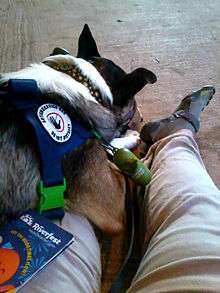Autism service dog
An autism service dog is a service dog trained to assist a person with autism to help them gain independence and the ability to perform activities of daily living similar to anyone else. For the most part, these dogs are trained to perform tasks similar to those of service dogs for other sensory processing disorders.

About
The first autism service dog was trained by National Service Dogs and placed with a child on the autism spectrum in 1997. Autism is a disability with symptoms that can vary from person to person.[1] [2] Training for autism service dogs is similar to guide dog training.[3] Autism service dogs cost between $12,000 and $30,000 and there is a long waiting list for the dogs.[4][5]
Anecdotal evidence of the efficacy of autism service dogs is greater than the amount of research on the practice.[6] Without more-objective standards, it can be difficult for parents, caregivers and educators to make a case for the need for autism service dogs.[7]
Function
Children
The primary focus of an autism service dog is to protect the safety of the children they work with.[3] Autism service dogs are sometimes trained to prevent children with autism from leaving the house unsupervised.[8] When autism service dogs are paired with children, the dog takes commands from the parents, not the child.[3] Autism service dogs also alert parents of dangerous situations regarding the children they work with.[9] Autism service dogs can help open the door for children and keep them from becoming over-stimulated.[10]
Some children with autism have been reported to have an increased sense of independence because of their interactions with the autism service dog.[11]
Sometimes a child harness - attached to an autism service dog - is worn by a child with autism. Vulnerable adults with autism may also wear such a harness.
Adults
As with hearing dogs for the deaf, the dogs may be trained to alert their handler to important noises or other things requiring human intervention, such as smoke or a smoke alarm, a crying baby, a telephone ringing, or a knock at the door. For an autistic person, it may not be immediately obvious which of the many external stimuli is the urgent one requiring their immediate attention. An autistic person may have to sort through both major and minor stimuli—the sound of crickets, the smell of the fabric softener on their clothes, a car driving past outside—to determine which of these, if any, needs their attention. They may understand that a smoke alarm is urgent and requires them to exit the building, but it might take more time to realize the alarm is sounding in the first place.[12]
Autism service dogs use a command to "ground" their owners by sitting on their feet, applying pressure when the owner is anxious.[13]
How service dogs are trained to respond to certain behaviors:[14]
| Behavior | Response |
|---|---|
| Self-stimulation | Will signal behavior to handler, handler may choose to stop (potentially harmful) |
| Self Injurious Behavior | Will interrupt behavior |
| Overstimulation/meltdown/shutdown | Deep pressure tasks: step on foot, paws on lap, lie on handler |
| Poor balance/motor control | Counterbalance, brace for stability |
| Disorientation | Find the car, go home, find other specified places |
| Auditory scene analysis | Alert to important sounds |
| Visual processing problems | Guide work - steer around obstacles |
See also
References
Citations
- 1957-, Pavlides, Merope (2008). Animal-assisted interventions for individuals with autism. London: Jessica Kingsley Publishers. ISBN 9781843108672. OCLC 289360730.CS1 maint: numeric names: authors list (link)
- Burrows, Adams & Millman 2008, p. 42.
- Burrows, Adams & Millman 2008, p. 43.
- Prewett, Nathan (2017-06-02). "Trussville family raising money for autism service dog for HTHS grad". The Trussville Tribune. Retrieved 2017-10-09.
- "Families seeking autism service dogs face years-long wait lists". CTVNews. 2017-05-28. Retrieved 2017-10-09.
- Butterly, Percy & Ward 2013, p. 2721.
- Butterly, Percy & Ward 2013, p. 2724.
- Simmons, Morgan (10 May 2009). "Autistic Child, Family Getting to Know New Service Dog". Knoxville News-Sentinel. Retrieved 9 October 2017 – via EBSCOhost.
- Burrows, Adams & Millman 2008, p. 56.
- McFarland, Laura (12 April 2017). "Powhatan 5-year-old bonds with autism service dog". Richmond Times-Dispatch. Retrieved 2017-10-09.
- O'Haire, ME (March 2013). "Review of current evidence and future directions in animal-assisted intervention for children with autism" (PDF). OA Autism. 10 (1): 1–5.
- Service Dog Central - Tasks for Autism Service Dogs Retrieved on January 28, 2008.
- Flores, Ben (2017-03-17). "In Focus, episode 1: Service dog helps woman navigate life with autism | Cronkite News". Cronkite News - Arizona PBS. Retrieved 2017-10-09.
- http://servicedogcentral.org/content/node/214
Sources
- Burrows, Kristen E.; Adams, Cindy L.; Millman, Suzanne T. (2008). "Factors Affecting Behavior and Welfare of Service Dogs for Children With Autism Spectrum Disorder" (PDF). Journal of Applied Animal Welfare Science. 11 (1): 42–62. doi:10.1080/10888700701555550. PMID 18444026.CS1 maint: ref=harv (link)
- Butterly, Felicity; Percy, Carol; Ward, Gillian (November 2013). "Brief Report: Do Service Dog Providers Placing Dogs with Children with Developmental Disabilities Use Outcome Measure and, If So, What Are They?". Journal of Autism and Developmental Disorders. 43 (11): 2720–2725. doi:10.1007/s10803-013-1803-1. PMID 23479076.CS1 maint: ref=harv (link)